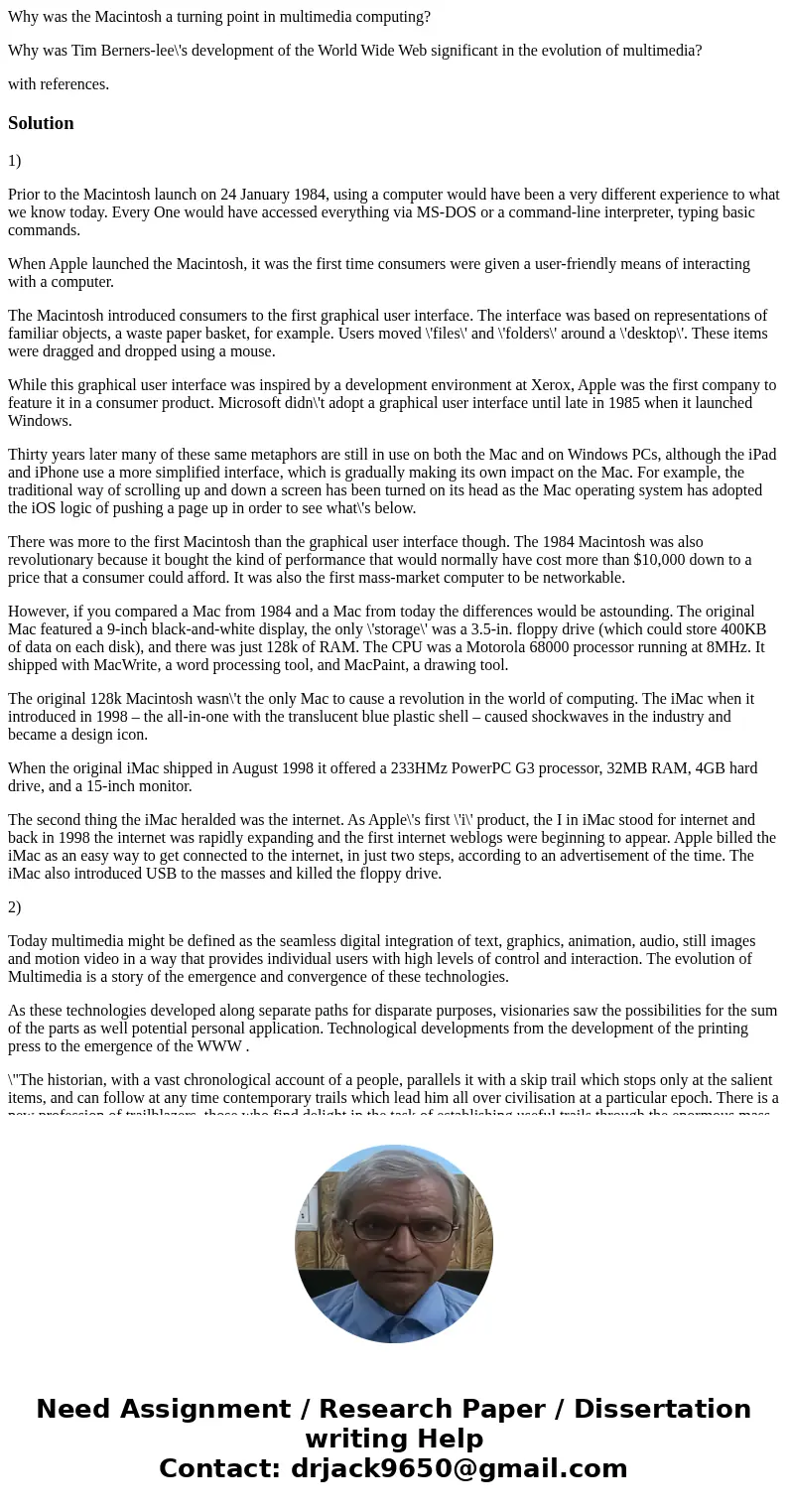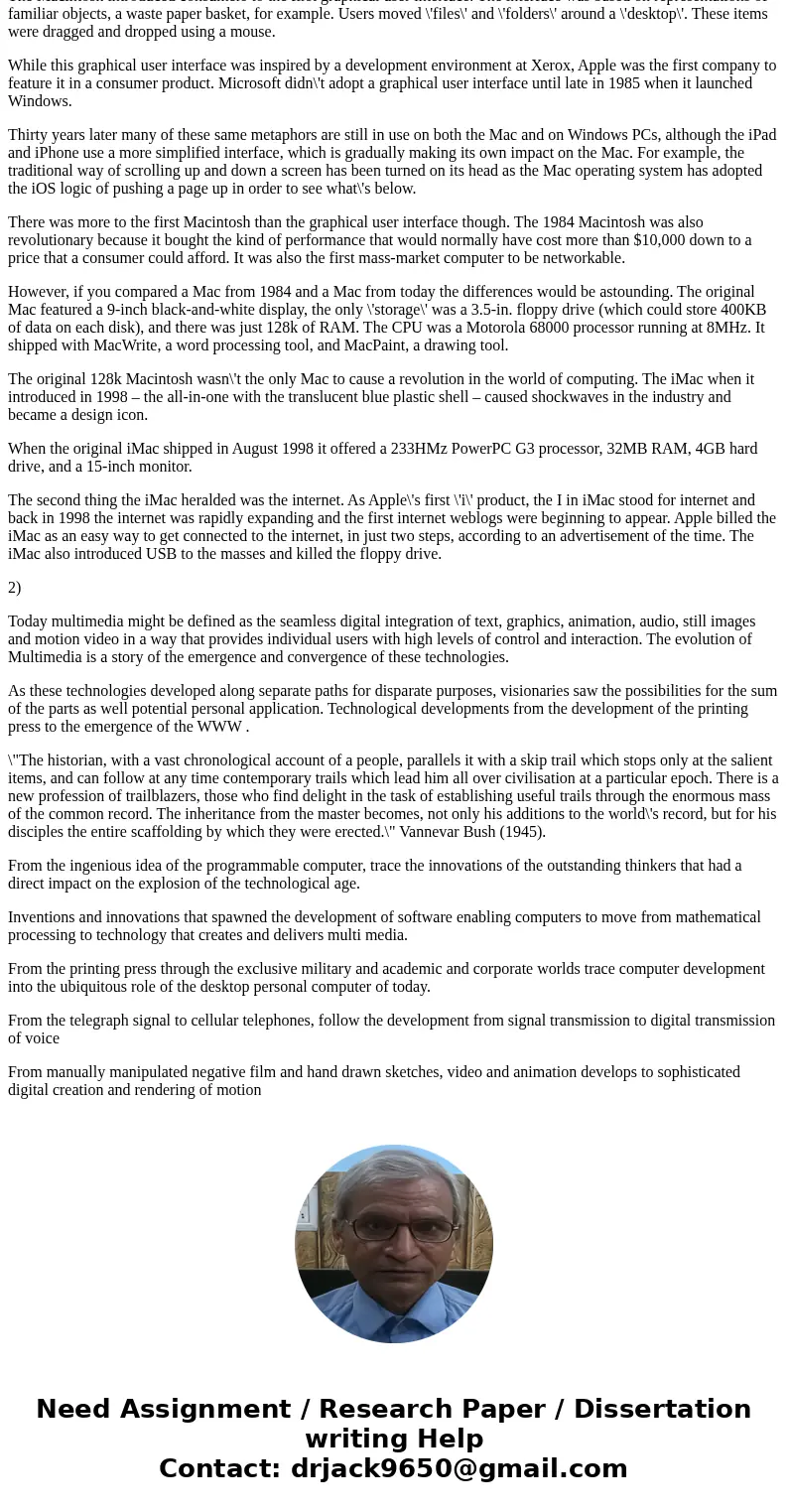Why was the Macintosh a turning point in multimedia computin
Why was the Macintosh a turning point in multimedia computing?
Why was Tim Berners-lee\'s development of the World Wide Web significant in the evolution of multimedia?
with references.
Solution
1)
Prior to the Macintosh launch on 24 January 1984, using a computer would have been a very different experience to what we know today. Every One would have accessed everything via MS-DOS or a command-line interpreter, typing basic commands.
When Apple launched the Macintosh, it was the first time consumers were given a user-friendly means of interacting with a computer.
The Macintosh introduced consumers to the first graphical user interface. The interface was based on representations of familiar objects, a waste paper basket, for example. Users moved \'files\' and \'folders\' around a \'desktop\'. These items were dragged and dropped using a mouse.
While this graphical user interface was inspired by a development environment at Xerox, Apple was the first company to feature it in a consumer product. Microsoft didn\'t adopt a graphical user interface until late in 1985 when it launched Windows.
Thirty years later many of these same metaphors are still in use on both the Mac and on Windows PCs, although the iPad and iPhone use a more simplified interface, which is gradually making its own impact on the Mac. For example, the traditional way of scrolling up and down a screen has been turned on its head as the Mac operating system has adopted the iOS logic of pushing a page up in order to see what\'s below.
There was more to the first Macintosh than the graphical user interface though. The 1984 Macintosh was also revolutionary because it bought the kind of performance that would normally have cost more than $10,000 down to a price that a consumer could afford. It was also the first mass-market computer to be networkable.
However, if you compared a Mac from 1984 and a Mac from today the differences would be astounding. The original Mac featured a 9-inch black-and-white display, the only \'storage\' was a 3.5-in. floppy drive (which could store 400KB of data on each disk), and there was just 128k of RAM. The CPU was a Motorola 68000 processor running at 8MHz. It shipped with MacWrite, a word processing tool, and MacPaint, a drawing tool.
The original 128k Macintosh wasn\'t the only Mac to cause a revolution in the world of computing. The iMac when it introduced in 1998 – the all-in-one with the translucent blue plastic shell – caused shockwaves in the industry and became a design icon.
When the original iMac shipped in August 1998 it offered a 233HMz PowerPC G3 processor, 32MB RAM, 4GB hard drive, and a 15-inch monitor.
The second thing the iMac heralded was the internet. As Apple\'s first \'i\' product, the I in iMac stood for internet and back in 1998 the internet was rapidly expanding and the first internet weblogs were beginning to appear. Apple billed the iMac as an easy way to get connected to the internet, in just two steps, according to an advertisement of the time. The iMac also introduced USB to the masses and killed the floppy drive.
2)
Today multimedia might be defined as the seamless digital integration of text, graphics, animation, audio, still images and motion video in a way that provides individual users with high levels of control and interaction. The evolution of Multimedia is a story of the emergence and convergence of these technologies.
As these technologies developed along separate paths for disparate purposes, visionaries saw the possibilities for the sum of the parts as well potential personal application. Technological developments from the development of the printing press to the emergence of the WWW .
\"The historian, with a vast chronological account of a people, parallels it with a skip trail which stops only at the salient items, and can follow at any time contemporary trails which lead him all over civilisation at a particular epoch. There is a new profession of trailblazers, those who find delight in the task of establishing useful trails through the enormous mass of the common record. The inheritance from the master becomes, not only his additions to the world\'s record, but for his disciples the entire scaffolding by which they were erected.\" Vannevar Bush (1945).
From the ingenious idea of the programmable computer, trace the innovations of the outstanding thinkers that had a direct impact on the explosion of the technological age.
Inventions and innovations that spawned the development of software enabling computers to move from mathematical processing to technology that creates and delivers multi media.
From the printing press through the exclusive military and academic and corporate worlds trace computer development into the ubiquitous role of the desktop personal computer of today.
From the telegraph signal to cellular telephones, follow the development from signal transmission to digital transmission of voice
From manually manipulated negative film and hand drawn sketches, video and animation develops to sophisticated digital creation and rendering of motion


 Homework Sourse
Homework Sourse